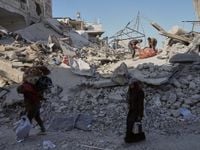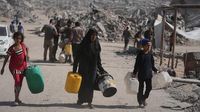The fragile ceasefire between Israel and Hamas, brokered just days ago, appears to be unraveling under the weight of renewed violence, diplomatic maneuvering, and deepening humanitarian crises. On October 14, 2025, Israel violated the ceasefire agreement by killing six Palestinians in Gaza City and another near Khan Yunis, as reported by Middle East Eye. At least five of those killed in Gaza City died in an aerial attack while inspecting the ruins of their destroyed homes, while the seventh was the victim of a drone strike in al-Fukhari, east of Khan Yunis. These acts directly contravene the October 10 ceasefire, which required all military operations—including aerial and artillery bombardment—to be suspended.
The ceasefire, which many hoped would mark a turning point after two years of relentless conflict, has instead been plagued by violations and uncertainty. On October 16, 2025, Israel killed three more people in Gaza, again breaching the agreement, according to updates reported by Al Jazeera. Meanwhile, U.S. President Donald Trump issued a stark warning, threatening "to go in and kill" Hamas if the group continued its attacks. Trump told Reuters, "If Hamas continues killing people in Gaza, we will have no choice but to intervene and kill them." The tone of these statements, coupled with ongoing military actions, has cast further doubt on the longevity and sincerity of the ceasefire.
Behind the scenes, diplomatic discussions have been intense. Israeli Prime Minister Benjamin Netanyahu briefed Trump on Israel’s planned steps in response to what Israel claims are Hamas’s delays in returning the bodies of deceased Israeli hostages. According to Israel Hayom, Trump expressed support for Israel’s measures, and the two leaders discussed the pace of body transfers from Gaza. The issue of the hostages’ remains has become a flashpoint: Israel announced it would halve the number of aid trucks allowed into Gaza—down to 300 per day—citing Hamas’s slow return of bodies. However, many of these remains may still be buried under rubble from Israeli bombings, complicating the process.
The humanitarian situation in Gaza remains dire. The Gaza Government Media Office reported that only 480 aid trucks entered the Strip on October 15—far short of the 600 daily trucks needed to meet basic needs. The enclave’s suffering is compounded by the near-total destruction of its infrastructure; nearly 80 percent of structures in Gaza have been fully or partly destroyed as of October 2025. The World Health Organization’s regional director, Hanan Balkhy, warned that disease outbreaks in Gaza are now "out of control," with only 13 of 36 hospitals partially functioning. The United Nations has called for all crossings into Gaza to be opened to expand humanitarian access, but Israel continues to bar international media from entering and recently blocked a Turkish delegation—including rescue teams and heavy equipment—from entering the Strip.
The violence has not been limited to Gaza. Israeli forces closed entrances to several villages east of Ramallah following a shooting attack, and a Palestinian was killed near the Qalandiya checkpoint north of Jerusalem. Widespread raids have taken place in the West Bank, including at the home of recently released prisoner Yusuf Dawoud. Illegal Jewish settlers destroyed over 150 olive trees in Bardala village in the North Jordan Valley, according to local reports. Israeli artillery continues to shell areas east of Gaza City’s Shujai’ya neighborhood, and satellite images show the Israeli army reinforcing deployment points in Gaza, including the Shuja’iyya neighborhood and the Philadelphi Axis along the border with Egypt.
Since October 7, 2023, the toll has been staggering: Israel has killed 67,967 and injured 170,179 Palestinians, the majority of whom are women and children, according to the Palestinian Ministry of Health in Gaza. The violence has not only devastated the population but also contributed to a growing sense of international isolation for Israel. Many European countries have suspended military aid and threatened economic sanctions, while massive antiwar demonstrations have erupted in Israel and around the world. In August 2025, hundreds of thousands of Israelis—including leading military and security officials—took to the streets to protest the ongoing war, signaling widespread recognition that continuing the conflict would yield little strategic value and further endanger hostages and soldiers alike.
The ceasefire agreement itself is a complex and controversial document. It calls for the creation of a technocratic Palestinian administration overseen by a "Board of Peace" chaired by Donald Trump, with former British Prime Minister Tony Blair also involved. This arrangement has provoked skepticism and resentment among Palestinians, who see it as yet another instance of foreign control supplanting their recognized government in Ramallah. Hamas, for its part, has agreed to step aside if Israel withdraws, but Israel—with U.S. backing—has ruled out allowing the Palestinian Authority (PA) to govern Gaza. The PA, which is recognized by 157 nations and has decades of governing experience in the West Bank, is widely seen as corrupt and dysfunctional, but remains the most likely entity to provide some measure of stability.
The challenges of reconstruction loom large. With nearly 80 percent of Gaza’s structures in ruins, the cost of rebuilding will be astronomical. Gulf States, who might otherwise finance reconstruction, remain hesitant as long as the threat of renewed war persists. As Middle East Eye noted, “It’s unlikely that the Gulf States will be willing to finance the removal of debris and mass reconstruction so long as there is still a possibility of the war resuming.”
Amid these staggering challenges, the plight of Palestinian prisoners and detainees has come to the fore. Nearly 2,000 Palestinians remain held without charge, and disturbing testimonies have emerged of brutal sexual assault and rape, with the use of sticks and police dogs, by Israeli prison authorities. The Director General of Hospitals in Gaza reported that bodies received from Israel showed clear signs of torture and tank tread marks, with only six of the 120 bodies identified so far.
Internationally, the political climate is shifting. Italian Foreign Minister Antonio Tajani announced that Italy’s recognition of a Palestinian state is "closer than ever," emphasizing that security in Gaza is a prerequisite for reconstruction. On the U.S. side, the State Department has dispatched a team to the Middle East to accelerate the flow of humanitarian aid into Gaza, while White House officials Steve Witkoff and Jared Kushner are coordinating efforts to locate the bodies of Israeli captives.
Despite these efforts, the future remains uncertain. Hamas officials have declared that "the battle did not and will not end with the silence of the guns—it continues," emphasizing that Palestinian national rights are non-negotiable and rejecting any form of international guardianship over the Palestinian people. The ongoing cycle of violence, failed diplomacy, and humanitarian catastrophe has left many questioning whether a sustainable peace is possible without a more fundamental shift in policy and approach from all parties involved.
As the ceasefire teeters on the brink, the world watches anxiously, hoping that the lessons of the past two years will not be lost—and that the suffering of Gaza’s people will finally come to an end.

